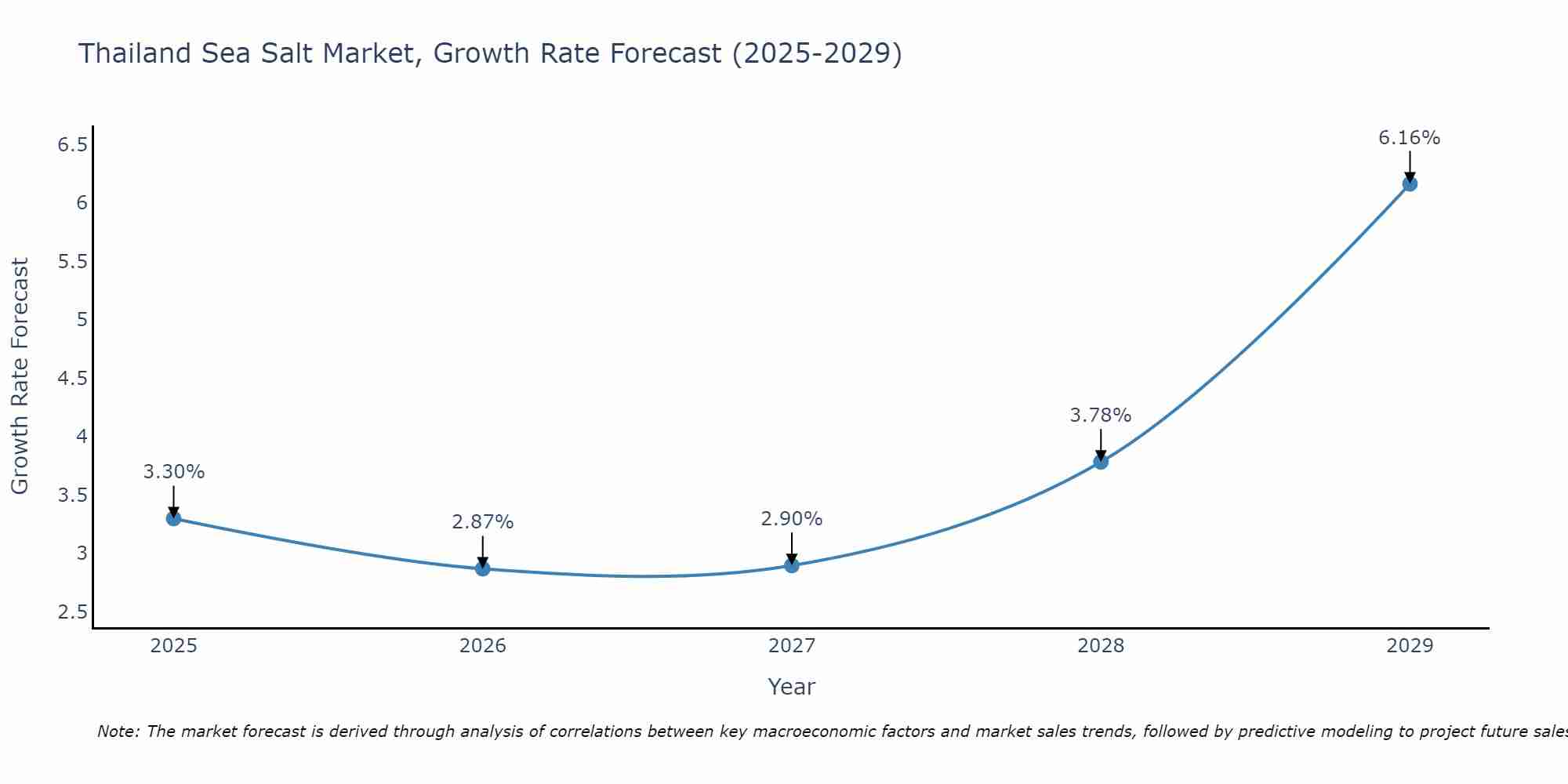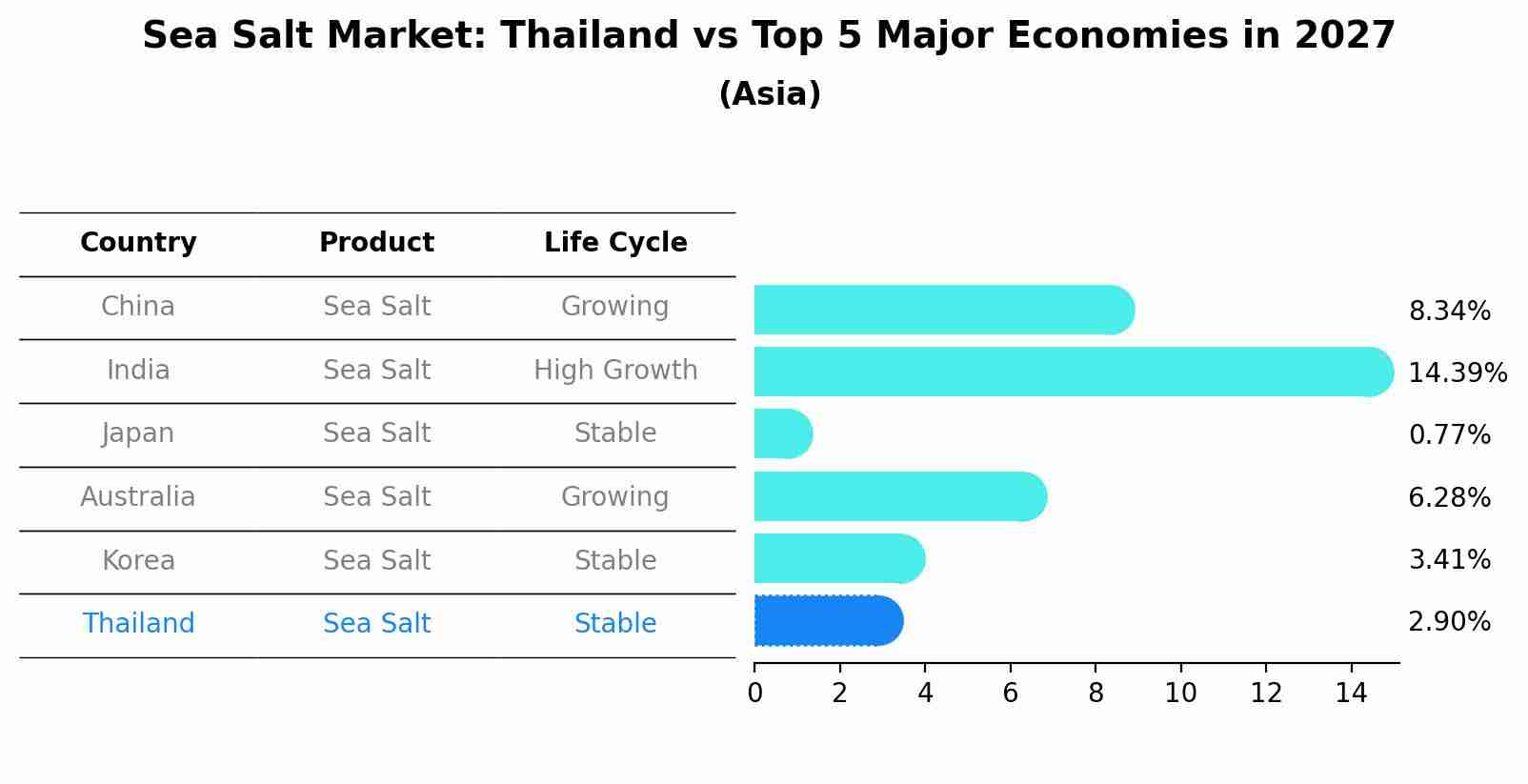Thailand Sea Salt Market (2025-2031) Outlook | Value, Growth, Forecast, Revenue, Companies, Size, Industry, Trends, Share & Analysis
| Product Code: ETC304825 | Publication Date: Aug 2022 | Updated Date: Aug 2025 | Product Type: Market Research Report | |
| Publisher: 6Wresearch | Author: Ravi Bhandari | No. of Pages: 75 | No. of Figures: 35 | No. of Tables: 20 |
Thailand Sea Salt Market Size Growth Rate
The Thailand Sea Salt Market is projected to witness mixed growth rate patterns during 2025 to 2029. The growth rate starts at 3.30% in 2025 and reaches 6.16% by 2029.

Sea Salt Market: Thailand vs Top 5 Major Economies in 2027 (Asia)
In the Asia region, the Sea Salt market in Thailand is projected to expand at a stable growth rate of 2.90% by 2027. The largest economy is China, followed by India, Japan, Australia and South Korea.

Thailand Sea Salt Market Synopsis
In the Thailand Sea Salt Market, the focus is on the production and distribution of high-quality sea salt products. Thai sea salt is renowned for its purity and mineral content, making it a sought-after commodity both domestically and internationally. The market`s expansion is driven by the growing demand for gourmet and artisanal salt products.
Drivers of the Market
The Thailand Sea Salt market is primarily driven by several factors, including the country`s extensive coastline and favorable climate conditions for salt production. Thailand`s abundant saltwater resources and the increasing demand for high-quality sea salt, both domestically and internationally, have spurred the growth of this market. Moreover, the growing awareness among consumers about the health benefits of sea salt compared to traditional table salt has further boosted its consumption. As a result, Thailand has witnessed a surge in sea salt production, with companies investing in advanced production technologies and quality control measures to meet the rising demand. Additionally, the export opportunities for Thai sea salt to neighboring countries and beyond have expanded, providing a significant growth avenue. Furthermore, the government`s support for the salt industry, in terms of regulatory frameworks and incentives, has played a pivotal role in the market`s development.
Challenges of the Market
Quality control and sustainable harvesting practices are challenges in the Sea Salt market. Meeting consumer expectations for pure and environmentally responsible sea salt production is essential for success.
COVID-19 Impact on the Market
The Thailand Sea Salt Market had mixed effects from the pandemic. Initially, there was a surge in demand for sea salt products, especially for cooking and preserving food at home. However, the market also faced supply chain disruptions as logistics and transportation were impacted. The shift towards online shopping platforms helped mitigate some of these challenges. Producers also adapted by enhancing their e-commerce presence. The market eventually regained stability as the situation improved.
Key Players in the Market
The Thailand Sea Salt market features leading producers like Thai Salt Harvesters Co., Ltd., Oceanic Salts Ltd., and PureSea Salts. These companies specialize in harvesting and processing sea salt, providing high-quality, natural salt products to both domestic and international markets.
Key Highlights of the Report:
- Thailand Sea Salt Market Outlook
- Market Size of Thailand Sea Salt Market, 2024
- Forecast of Thailand Sea Salt Market, 2031
- Historical Data and Forecast of Thailand Sea Salt Revenues & Volume for the Period 2021-2031
- Thailand Sea Salt Market Trend Evolution
- Thailand Sea Salt Market Drivers and Challenges
- Thailand Sea Salt Price Trends
- Thailand Sea Salt Porter's Five Forces
- Thailand Sea Salt Industry Life Cycle
- Historical Data and Forecast of Thailand Sea Salt Market Revenues & Volume By Distribution Channel for the Period 2021-2031
- Historical Data and Forecast of Thailand Sea Salt Market Revenues & Volume By Direct/BB for the Period 2021-2031
- Historical Data and Forecast of Thailand Sea Salt Market Revenues & Volume By Indirect/B2C for the Period 2021-2031
- Historical Data and Forecast of Thailand Sea Salt Market Revenues & Volume By End Use for the Period 2021-2031
- Historical Data and Forecast of Thailand Sea Salt Market Revenues & Volume By Agriculture for the Period 2021-2031
- Historical Data and Forecast of Thailand Sea Salt Market Revenues & Volume By Cosmetics for the Period 2021-2031
- Historical Data and Forecast of Thailand Sea Salt Market Revenues & Volume By Animal Feed for the Period 2021-2031
- Historical Data and Forecast of Thailand Sea Salt Market Revenues & Volume By Horeca for the Period 2021-2031
- Historical Data and Forecast of Thailand Sea Salt Market Revenues & Volume By Food Industry for the Period 2021-2031
- Thailand Sea Salt Import Export Trade Statistics
- Market Opportunity Assessment By Distribution Channel
- Market Opportunity Assessment By End Use
- Thailand Sea Salt Top Companies Market Share
- Thailand Sea Salt Competitive Benchmarking By Technical and Operational Parameters
- Thailand Sea Salt Company Profiles
- Thailand Sea Salt Key Strategic Recommendations
Frequently Asked Questions About the Market Study (FAQs):
1 Executive Summary |
2 Introduction |
2.1 Key Highlights of the Report |
2.2 Report Description |
2.3 Market Scope & Segmentation |
2.4 Research Methodology |
2.5 Assumptions |
3 Thailand Sea Salt Market Overview |
3.1 Thailand Country Macro Economic Indicators |
3.2 Thailand Sea Salt Market Revenues & Volume, 2021 & 2031F |
3.3 Thailand Sea Salt Market - Industry Life Cycle |
3.4 Thailand Sea Salt Market - Porter's Five Forces |
3.5 Thailand Sea Salt Market Revenues & Volume Share, By Distribution Channel, 2021 & 2031F |
3.6 Thailand Sea Salt Market Revenues & Volume Share, By End Use, 2021 & 2031F |
4 Thailand Sea Salt Market Dynamics |
4.1 Impact Analysis |
4.2 Market Drivers |
4.2.1 Increasing consumer awareness about the health benefits of sea salt |
4.2.2 Growing demand for organic and natural products |
4.2.3 Rising popularity of Thai cuisine globally |
4.3 Market Restraints |
4.3.1 Seasonal variations affecting salt production |
4.3.2 Price fluctuations in the global salt market |
4.3.3 Environmental concerns related to salt production and waste disposal |
5 Thailand Sea Salt Market Trends |
6 Thailand Sea Salt Market, By Types |
6.1 Thailand Sea Salt Market, By Distribution Channel |
6.1.1 Overview and Analysis |
6.1.2 Thailand Sea Salt Market Revenues & Volume, By Distribution Channel, 2021-2031F |
6.1.3 Thailand Sea Salt Market Revenues & Volume, By Direct/BB, 2021-2031F |
6.1.4 Thailand Sea Salt Market Revenues & Volume, By Indirect/B2C, 2021-2031F |
6.2 Thailand Sea Salt Market, By End Use |
6.2.1 Overview and Analysis |
6.2.2 Thailand Sea Salt Market Revenues & Volume, By Agriculture, 2021-2031F |
6.2.3 Thailand Sea Salt Market Revenues & Volume, By Cosmetics, 2021-2031F |
6.2.4 Thailand Sea Salt Market Revenues & Volume, By Animal Feed, 2021-2031F |
6.2.5 Thailand Sea Salt Market Revenues & Volume, By Horeca, 2021-2031F |
6.2.6 Thailand Sea Salt Market Revenues & Volume, By Food Industry, 2021-2031F |
7 Thailand Sea Salt Market Import-Export Trade Statistics |
7.1 Thailand Sea Salt Market Export to Major Countries |
7.2 Thailand Sea Salt Market Imports from Major Countries |
8 Thailand Sea Salt Market Key Performance Indicators |
8.1 Percentage of market share within the organic salt segment |
8.2 Number of new product launches in the premium sea salt category |
8.3 Growth in export volume of Thai sea salt |
9 Thailand Sea Salt Market - Opportunity Assessment |
9.1 Thailand Sea Salt Market Opportunity Assessment, By Distribution Channel, 2021 & 2031F |
9.2 Thailand Sea Salt Market Opportunity Assessment, By End Use, 2021 & 2031F |
10 Thailand Sea Salt Market - Competitive Landscape |
10.1 Thailand Sea Salt Market Revenue Share, By Companies, 2024 |
10.2 Thailand Sea Salt Market Competitive Benchmarking, By Operating and Technical Parameters |
11 Company Profiles |
12 Recommendations |
13 Disclaimer |
- Single User License$ 1,995
- Department License$ 2,400
- Site License$ 3,120
- Global License$ 3,795
Search
Thought Leadership and Analyst Meet
Our Clients
Related Reports
- Afghanistan Apparel Market (2026-2032) | Growth, Outlook, Industry, Segmentation, Forecast, Size, Companies, Trends, Value, Share, Analysis & Revenue
- Canada Oil and Gas Market (2026-2032) | Share, Segmentation, Value, Industry, Trends, Forecast, Analysis, Size & Revenue, Growth, Competitive Landscape, Outlook, Companies
- Germany Breakfast Food Market (2026-2032) | Industry, Share, Growth, Size, Companies, Value, Analysis, Revenue, Trends, Forecast & Outlook
- Australia Briquette Market (2025-2031) | Growth, Size, Revenue, Forecast, Analysis, Trends, Value, Share, Industry & Companies
- Vietnam System Integrator Market (2025-2031) | Size, Companies, Analysis, Industry, Value, Forecast, Growth, Trends, Revenue & Share
- ASEAN and Thailand Brain Health Supplements Market (2025-2031) | Strategy, Consumer Insights, Analysis, Investment Trends, Opportunities, Growth, Size, Share, Industry, Revenue, Segments, Value, Segmentation, Supply, Forecast, Restraints, Outlook, Competition, Drivers, Trends, Demand, Pricing Analysis, Competitive, Strategic Insights, Companies, Challenges
- ASEAN Bearings Market (2025-2031) | Strategy, Consumer Insights, Analysis, Investment Trends, Opportunities, Growth, Size, Share, Industry, Revenue, Segments, Value, Segmentation, Supply, Forecast, Restraints, Outlook, Competition, Drivers, Trends, Demand, Pricing Analysis, Competitive, Strategic Insights, Companies, Challenges
- Europe Flooring Market (2025-2031) | Outlook, Share, Industry, Trends, Forecast, Companies, Revenue, Size, Analysis, Growth & Value
- Saudi Arabia Manlift Market (2025-2031) | Outlook, Size, Growth, Trends, Companies, Industry, Revenue, Value, Share, Forecast & Analysis
- Uganda Excavator, Crane, and Wheel Loaders Market (2025-2031) | Strategy, Consumer Insights, Analysis, Investment Trends, Opportunities, Growth, Size, Share, Industry, Revenue, Segments, Value, Segmentation, Supply, Forecast, Restraints, Outlook, Competition, Drivers, Trends, Demand, Pricing Analysis, Competitive, Strategic Insights, Companies, Challenges
Industry Events and Analyst Meet
Whitepaper
- Middle East & Africa Commercial Security Market Click here to view more.
- Middle East & Africa Fire Safety Systems & Equipment Market Click here to view more.
- GCC Drone Market Click here to view more.
- Middle East Lighting Fixture Market Click here to view more.
- GCC Physical & Perimeter Security Market Click here to view more.
6WResearch In News
- Doha a strategic location for EV manufacturing hub: IPA Qatar
- Demand for luxury TVs surging in the GCC, says Samsung
- Empowering Growth: The Thriving Journey of Bangladesh’s Cable Industry
- Demand for luxury TVs surging in the GCC, says Samsung
- Video call with a traditional healer? Once unthinkable, it’s now common in South Africa
- Intelligent Buildings To Smooth GCC’s Path To Net Zero


















